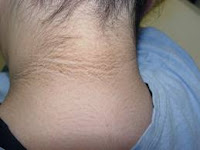Acanthosis nigricans
 Acanthosis nigricans (ak-an-THOE-sis NIE-grih-kuns) is a skin condition
characterized by areas of dark, velvety discoloration in body folds and
creases. The affected skin can become thickened and may smell bad. Most
often, acanthosis nigricans affects your armpits, groin and neck.
Acanthosis nigricans (ak-an-THOE-sis NIE-grih-kuns) is a skin condition
characterized by areas of dark, velvety discoloration in body folds and
creases. The affected skin can become thickened and may smell bad. Most
often, acanthosis nigricans affects your armpits, groin and neck.
These skin changes typically occur in people who are obese or have diabetes.
Children who develop the condition are at higher risk of developing type 2 diabetes. More rarely, acanthosis nigricans can be a warning sign of a cancerous tumor in an internal organ, such as the stomach or liver.
Acanthosis nigricans is most common in Native Americans, blacks and Hispanics. There's no specific treatment for acanthosis nigricans. Treatment of underlying conditions may restore some of the normal color and texture to affected areas of skin.
Symptoms:
Skin changes are the only signs of acanthosis nigricans. You'll notice dark, thickened, velvety skin in body folds and creases — typically in your armpits, groin and neck. The skin changes appear slowly, sometimes over months or years. The affected skin may also smell bad or itch.
When to see a doctor:
Consult your doctor if you notice changes in your skin — especially if the changes appear suddenly. You may have an underlying condition that needs treatment.
Causes :
Acanthosis nigricans has been associated with:
People who have acanthosis nigricans are much more likely to develop type 2 diabetes. They also should be thoroughly checked for the types of cancers that have been linked to the disorder.
Treatments and drugs:
In many situations, treating the underlying problem can help fade the discoloration. Examples may include:
Definition:
 Acanthosis nigricans (ak-an-THOE-sis NIE-grih-kuns) is a skin condition
characterized by areas of dark, velvety discoloration in body folds and
creases. The affected skin can become thickened and may smell bad. Most
often, acanthosis nigricans affects your armpits, groin and neck.
Acanthosis nigricans (ak-an-THOE-sis NIE-grih-kuns) is a skin condition
characterized by areas of dark, velvety discoloration in body folds and
creases. The affected skin can become thickened and may smell bad. Most
often, acanthosis nigricans affects your armpits, groin and neck.
These skin changes typically occur in people who are obese or have diabetes.
Children who develop the condition are at higher risk of developing type 2 diabetes. More rarely, acanthosis nigricans can be a warning sign of a cancerous tumor in an internal organ, such as the stomach or liver.
Acanthosis nigricans is most common in Native Americans, blacks and Hispanics. There's no specific treatment for acanthosis nigricans. Treatment of underlying conditions may restore some of the normal color and texture to affected areas of skin.
Symptoms:
Skin changes are the only signs of acanthosis nigricans. You'll notice dark, thickened, velvety skin in body folds and creases — typically in your armpits, groin and neck. The skin changes appear slowly, sometimes over months or years. The affected skin may also smell bad or itch.
When to see a doctor:
Consult your doctor if you notice changes in your skin — especially if the changes appear suddenly. You may have an underlying condition that needs treatment.
Causes :
Acanthosis nigricans has been associated with:
- Insulin resistance. Most people who have acanthosis nigricans have also become resistant to insulin, a hormone secreted by the pancreas that allows your body to process sugar. Insulin resistance is what eventually causes type 2 diabetes.
- Obesity. Most people who develop acanthosis nigricans are overweight or obese, which is a strong risk factor for developing insulin resistance.
- Hormonal disorders. Acanthosis nigricans often occurs in people who have disorders such as ovarian cysts, underactive thyroids or problems with the adrenal glands.
- Certain drugs. Medications such as oral contraceptives and corticosteroids, such as prednisone, may cause acanthosis nigricans — as can high doses of niacin.
- Cancer. Acanthosis nigricans also sometimes occurs when a cancerous tumor begins growing in an internal organ, such as the stomach, colon or liver.
People who have acanthosis nigricans are much more likely to develop type 2 diabetes. They also should be thoroughly checked for the types of cancers that have been linked to the disorder.
Treatments and drugs:
In many situations, treating the underlying problem can help fade the discoloration. Examples may include:
- Lose weight. If your acanthosis nigricans is caused by obesity, losing weight may help.
- Take medications. Symptoms may be relieved by treatment for underlying problems with your ovaries, adrenal glands or thyroid.
- Surgery. If acanthosis nigricans was triggered by a cancerous tumor, surgically removing the tumor often clears up the skin discoloration.
- Prescription creams to lighten the affected areas
- Antibacterial soaps or a topical antibiotic to reduce odor
- Oral acne medications
- Laser therapy to reduce the skin's thickness










0 komentar:
Posting Komentar